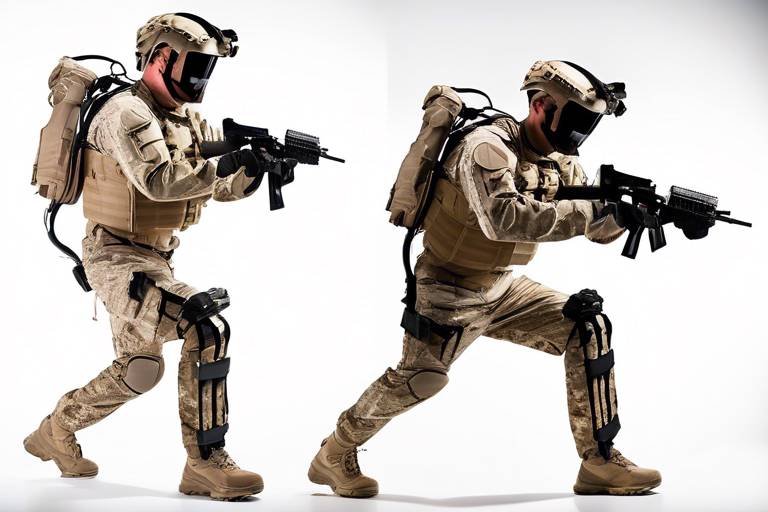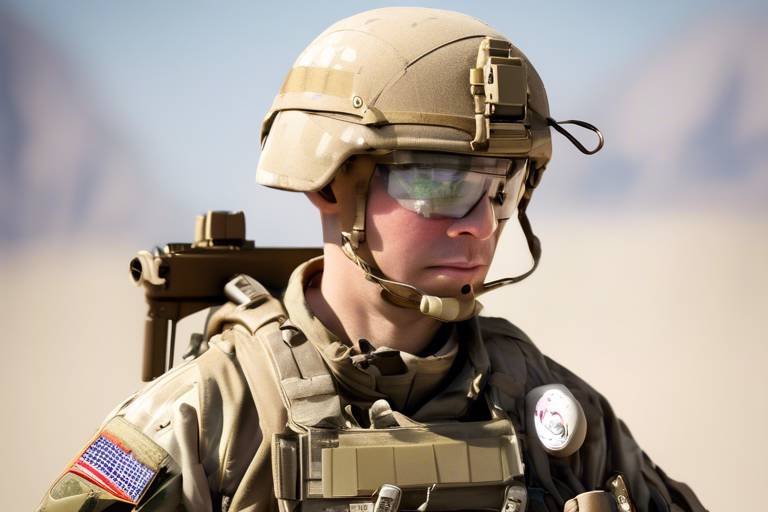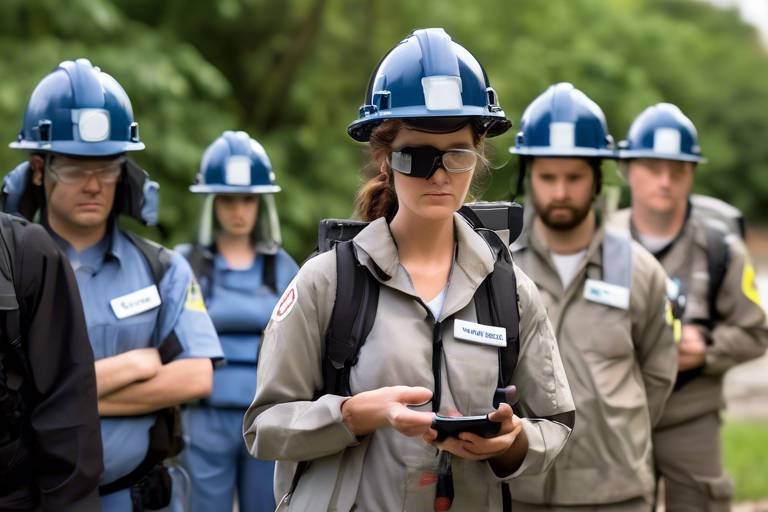How Exoskeletons Enhance Soldier Performance
In the ever-evolving landscape of military technology, exoskeletons stand out as a revolutionary advancement that is reshaping the battlefield. Imagine a soldier equipped with a powerful, wearable suit that not only amplifies their strength but also enhances their endurance. This is not science fiction; it's the reality of modern warfare. Exoskeletons are designed to augment human capabilities, allowing soldiers to carry heavier loads, traverse challenging terrains, and maintain peak performance over extended periods. As we dive deeper into this topic, we will explore how these remarkable devices are transforming military operations and the lives of those who serve.
Exoskeletons are essentially wearable robotic devices that work in tandem with the human body, providing support and enhancing physical abilities. These devices come in various forms, from full-body suits to more targeted designs that assist specific limbs. The technology behind exoskeletons involves a combination of sensors, motors, and artificial intelligence that work together to respond to the user's movements. When a soldier moves, the exoskeleton amplifies that motion, allowing for greater strength and efficiency.
The advantages of exoskeletons in military settings are numerous and impactful. For starters, they significantly increase strength and reduce fatigue, which are crucial factors in combat scenarios. Imagine a soldier who can carry twice the weight of their gear without feeling the strain. This not only enhances their performance but also contributes to mission success. Furthermore, exoskeletons improve mobility, allowing soldiers to navigate difficult terrains with ease. Whether it’s climbing steep hills or moving through rubble, these devices provide the necessary support to keep soldiers agile and ready for action.
One of the most significant benefits of exoskeletons is the increased strength they provide. Soldiers often carry heavy equipment, which can lead to fatigue and injury. With an exoskeleton, they can carry loads that would typically be impossible without excessive strain. This enhancement not only boosts operational efficiency but also reduces the risk of injuries that can occur from carrying heavy packs over long distances. For instance, a soldier equipped with an exoskeleton can carry up to 100 pounds without feeling the burden, allowing them to focus on their mission rather than their fatigue.
There have been several instances where exoskeletons have been deployed in combat situations, showcasing their effectiveness. For example, during a recent military exercise, soldiers using exoskeletons were able to move supplies and equipment faster than their counterparts without such technology. This not only improved logistics but also allowed for quicker response times in critical situations. The feedback from soldiers has been overwhelmingly positive, with many reporting that the exoskeletons made them feel invincible, allowing them to push their limits like never before.
Beyond immediate performance benefits, exoskeletons hold the potential for long-term health improvements for soldiers. Chronic injuries associated with heavy load carrying and repetitive strain are common in military personnel. By using exoskeletons, soldiers can mitigate these risks, leading to a healthier and more sustainable career in the armed forces. Imagine a future where soldiers can serve longer without the debilitating injuries that often cut careers short. This is the promise that exoskeleton technology holds.
Exoskeletons also play a crucial role in enhancing soldiers' endurance and mobility. With the ability to perform tasks for extended periods without succumbing to fatigue, soldiers can maintain operational effectiveness even in the most demanding conditions. Think of it as having a personal assistant that not only helps you carry your load but also boosts your stamina. This enhancement allows soldiers to focus on their missions, whether it’s engaging in combat or conducting reconnaissance, without the constant worry of physical exhaustion.
Despite the numerous advantages, the implementation of exoskeleton technology is not without its challenges. Issues such as high costs, the need for extensive training, and integration into existing military systems pose significant hurdles. For instance, the initial investment required for developing and deploying these systems can be substantial. Military organizations must carefully consider their budgets and prioritize resources accordingly.
The financial implications of implementing exoskeleton technology cannot be overlooked. With budget constraints in many military organizations, the allocation of resources becomes a critical factor. It's essential to weigh the long-term benefits against the upfront costs. This often leads to difficult decisions about which technologies to prioritize. However, as the benefits of exoskeletons become more evident, there may be a shift in funding priorities.
Another significant challenge is the training required for soldiers to adapt to using exoskeletons effectively. Comprehensive training programs are essential to ensure that personnel can maximize the benefits of these devices. The learning curve can be steep, and without proper training, soldiers may struggle to operate the technology effectively. This adaptation period is crucial for successful integration into military operations.
- What are exoskeletons? Exoskeletons are wearable robotic devices designed to enhance human physical capabilities.
- How do exoskeletons benefit soldiers? They increase strength, reduce fatigue, and improve mobility, leading to enhanced performance on the battlefield.
- Are there any health benefits associated with exoskeletons? Yes, they can help mitigate chronic injuries related to heavy load carrying and repetitive strain.
- What challenges exist in implementing exoskeleton technology? Challenges include high costs, training requirements, and the integration into existing military systems.
Introduction to Exoskeleton Technology
Exoskeletons are revolutionizing the way we think about human capabilities, especially in the military sector. These wearable robotic devices are designed to augment the physical abilities of soldiers, enabling them to perform tasks that would otherwise be impossible or extremely taxing on the body. Imagine strapping on a suit that not only lifts heavy loads but also enhances your endurance and agility, allowing you to traverse rugged terrains with ease. This is the promise of exoskeleton technology.
The basic principle behind exoskeletons is rather straightforward: they are engineered to work in tandem with the human body, amplifying its natural strength and capabilities. These devices can be classified into two main types: passive and active exoskeletons. Passive exoskeletons rely on mechanical structures to redistribute weight and reduce strain, while active exoskeletons incorporate motors and sensors to actively assist the user in movement.
At their core, exoskeletons are built on advanced technologies, including robotics, artificial intelligence, and biomechanics. These components work together to create a seamless experience for the user, allowing for natural movement and reduced fatigue. For instance, sensors embedded in the suit can detect the user's movements and adjust accordingly, providing the right amount of support when lifting heavy equipment or navigating difficult terrain.
As military forces around the world seek to enhance the performance of their personnel, the integration of exoskeleton technology is becoming increasingly vital. Not only do these devices promise to improve operational efficiency, but they also offer significant potential for injury prevention. By reducing the physical strain on soldiers, exoskeletons can help mitigate the risk of chronic injuries that often arise from carrying heavy loads or performing repetitive tasks.
In summary, exoskeleton technology represents a significant leap forward in enhancing soldier capabilities. As we delve deeper into the benefits and applications of these remarkable devices, it becomes evident that they are not just a futuristic concept, but a present-day reality with the potential to reshape military operations.
Benefits of Exoskeletons for Soldiers
Exoskeletons are revolutionizing the way soldiers operate on the battlefield, offering a plethora of advantages that enhance their capabilities and overall performance. Imagine being able to lift and carry heavy equipment with ease, all while feeling less fatigued and more agile. This is the reality that exoskeleton technology brings to military personnel. The primary benefits of these advanced devices can be categorized into several key areas, including increased strength, reduced fatigue, and enhanced mobility. Let's delve deeper into how these advantages translate into improved performance and mission success.
One of the most significant benefits of exoskeletons is their ability to amplify a soldier’s physical strength. These wearable robots can assist in lifting heavy loads, allowing soldiers to carry equipment that would typically be beyond their physical limits. For instance, a soldier equipped with an exoskeleton can transport supplies, weapons, and other essential gear without the usual strain on their body. This increased load-bearing capacity not only boosts operational efficiency but also significantly reduces the risk of injuries associated with heavy lifting. In a high-pressure situation, every ounce of strength counts, and exoskeletons can be the difference between success and failure.
Moreover, the impact of exoskeletons on fatigue reduction cannot be overstated. Soldiers often face long hours of physical exertion, which can lead to exhaustion and decreased performance. With the support of an exoskeleton, soldiers can maintain their stamina for longer periods, allowing them to complete missions that require sustained effort. Imagine running a marathon versus having a friend carry you on their back; the latter allows you to conserve energy and perform better over time. Exoskeletons act as that supportive friend, enabling soldiers to push through demanding tasks without succumbing to fatigue.
In addition to strength and fatigue management, exoskeletons also enhance mobility. These devices are designed to improve the agility and maneuverability of soldiers in challenging terrains. Whether navigating rocky landscapes or urban environments, exoskeletons can provide the necessary support to maintain balance and stability. This enhanced mobility is crucial during combat scenarios, where quick reflexes and the ability to react swiftly can make all the difference. Picture a soldier in a tight spot, needing to dodge incoming fire or quickly reposition themselves; exoskeletons can facilitate those rapid movements, ensuring they stay one step ahead of the enemy.
To illustrate these benefits further, consider the following table that summarizes the key advantages of exoskeletons for soldiers:
| Benefit | Description |
|---|---|
| Increased Strength | Allows soldiers to carry heavier loads with less physical strain, enhancing operational efficiency. |
| Reduced Fatigue | Enables soldiers to maintain stamina over extended periods, improving mission performance. |
| Enhanced Mobility | Improves agility and maneuverability, allowing soldiers to navigate challenging environments effectively. |
In summary, the integration of exoskeleton technology into military operations presents a transformative opportunity for enhancing soldier performance. By increasing strength, reducing fatigue, and improving mobility, exoskeletons equip soldiers with the tools they need to excel in their missions. As military technology continues to evolve, the potential for exoskeletons to reshape the battlefield is not just a possibility; it is becoming a reality.
Q1: How do exoskeletons work?
Exoskeletons use a combination of sensors, motors, and advanced algorithms to assist the wearer's movements. They detect the user's actions and provide mechanical support to enhance strength and mobility.
Q2: Are exoskeletons heavy or cumbersome?
Modern exoskeletons are designed to be lightweight and ergonomic, ensuring that they do not hinder the soldier’s movement. Developers focus on creating devices that feel like a natural extension of the body.
Q3: What types of exoskeletons are available for military use?
There are various types of exoskeletons, including those designed for load-bearing support, mobility enhancement, and rehabilitation purposes. Each type serves a specific function to meet the needs of military personnel.
Q4: How do soldiers train to use exoskeletons?
Comprehensive training programs are essential for soldiers to adapt to using exoskeletons effectively. These programs focus on familiarizing soldiers with the technology and practicing its use in various scenarios.
Increased Strength and Load-Bearing Capacity
One of the most remarkable benefits of exoskeleton technology for soldiers is the increased strength and load-bearing capacity it provides. Imagine a soldier who can carry supplies, equipment, and weaponry that would normally be impossible to manage without severe strain or fatigue. Exoskeletons act like a second skin, amplifying the wearer's strength and allowing them to lift and transport heavy loads with ease. This enhanced capability not only improves operational efficiency but also plays a crucial role in reducing the risk of injuries caused by heavy lifting.
The mechanics behind these devices are fascinating. Exoskeletons utilize a combination of advanced robotics, sensors, and artificial intelligence to support and augment human movement. When a soldier bends down to pick up a heavy object, the exoskeleton senses this motion and activates its motors to assist, effectively distributing the weight and minimizing the strain on the soldier’s muscles and joints. This can be a game-changer in combat situations where mobility and endurance are vital.
Consider the following key points about the impact of increased strength and load-bearing capacity:
- Operational Efficiency: Soldiers equipped with exoskeletons can carry significantly more gear, which can include medical supplies, ammunition, or communication equipment, without compromising their speed or agility.
- Reduced Injury Risk: By alleviating the physical burden of heavy lifting, exoskeletons help prevent chronic injuries such as back pain or joint issues that are common among soldiers.
- Enhanced Team Performance: When all members of a unit are equipped with exoskeletons, the collective strength and efficiency of the team can increase dramatically, allowing for more ambitious missions and strategies.
Real-world applications of exoskeletons have already shown promising results in combat scenarios. For example, during recent military exercises, units equipped with exoskeleton technology reported a noticeable decrease in fatigue levels after long missions. This not only enhances their immediate performance but also contributes to their overall combat readiness and health over time. Soldiers found that they could cover more ground and carry more equipment without feeling the typical exhaustion that comes with such demanding tasks.
In summary, the integration of exoskeletons into military operations represents a revolutionary step forward in enhancing soldier capabilities. By increasing strength and load-bearing capacity, these devices not only improve individual performance but also contribute to the effectiveness of military units as a whole. As technology continues to evolve, the potential for exoskeletons to transform the battlefield experience for soldiers is both exciting and promising.
Real-World Applications in Combat
Exoskeletons are not just futuristic concepts confined to the realms of science fiction; they are actively being integrated into military operations around the globe. Imagine a soldier equipped with a wearable robotic suit that enhances their physical abilities, enabling them to carry heavy equipment, traverse difficult terrains, and perform demanding tasks with ease. This is not a scene from a movie—it's happening right now in various combat scenarios.
One notable example is the use of exoskeletons in the U.S. Army’s Warrior Web program. This initiative aims to develop a lightweight, modular exoskeleton that can support soldiers in various missions. During field tests, soldiers wearing these exoskeletons have reported significant improvements in their ability to carry heavy loads over long distances without experiencing the usual fatigue. This enhanced capacity not only boosts their physical performance but also contributes to overall mission success.
Moreover, in recent military exercises, exoskeletons have been deployed to assist in logistical operations. Soldiers equipped with these suits have demonstrated the ability to lift and transport supplies that would typically require multiple personnel. For instance, during a joint training exercise, units utilizing exoskeletons were able to move equipment faster and more efficiently, allowing them to respond to simulated combat scenarios with greater agility.
Another compelling application is seen in the context of medical evacuation. Exoskeletons can facilitate the rapid transport of injured soldiers from the battlefield to medical facilities. By enabling medics to carry wounded personnel without straining their bodies, these devices can significantly reduce the time it takes to provide critical care. The implications for survival rates in combat situations are profound, as every second counts when a soldier is in need of urgent medical attention.
Furthermore, exoskeleton technology is being explored for use in urban warfare, where maneuverability and strength are paramount. Soldiers navigating through complex environments, such as buildings or debris-laden streets, can benefit from the enhanced stability and support provided by exoskeletons. The increased strength allows them to lift obstacles or carry additional gear without the risk of injury, ultimately improving their effectiveness in high-stakes situations.
While the potential applications are exciting, it is essential to recognize that the integration of exoskeletons into military operations is still in its early stages. Continuous testing and refinement are necessary to ensure that these devices can withstand the rigors of combat and meet the unique demands placed on soldiers in various environments.
In summary, the real-world applications of exoskeletons in combat are paving the way for a new era of military capability. As technology advances, we can expect to see even more innovative uses that enhance soldier performance, improve operational efficiency, and ultimately save lives on the battlefield.
- What are exoskeletons? Exoskeletons are wearable robotic devices designed to augment human physical capabilities, providing enhanced strength, endurance, and mobility.
- How do exoskeletons benefit soldiers? They help soldiers carry heavier loads, reduce fatigue, enhance mobility, and prevent injuries, contributing to better performance in combat.
- Are exoskeletons currently in use? Yes, exoskeletons are being tested and utilized in various military applications, including logistics, medical evacuation, and combat scenarios.
- What challenges exist in implementing exoskeletons? Key challenges include cost, resource allocation, training requirements, and integration into existing military systems.
Long-term Impacts on Soldier Health
When we think about the physical demands placed on soldiers, it's easy to overlook the long-term consequences of carrying heavy loads and performing strenuous activities day in and day out. This is where exoskeleton technology steps in as a game-changer. Imagine a world where soldiers can operate at peak performance without the looming threat of chronic injuries. Exoskeletons not only enhance immediate capabilities but also pave the way for healthier, more sustainable military careers.
One of the most significant benefits of exoskeletons is their ability to reduce the risk of common injuries associated with heavy lifting and repetitive motions. Soldiers often suffer from ailments like back pain, joint issues, and muscle fatigue due to the rigorous nature of their duties. With the support of an exoskeleton, these risks can be substantially mitigated. For instance, a study found that soldiers using exoskeletons reported a 50% reduction in lower back strain during training exercises, showcasing how these devices can lead to a healthier workforce.
Moreover, the long-term use of exoskeletons can contribute to a decrease in chronic conditions that plague many veterans. Conditions such as osteoarthritis and chronic pain syndromes can stem from years of physical strain. By integrating exoskeleton technology into military operations, we can potentially extend the operational life of soldiers while simultaneously enhancing their quality of life post-service.
In addition to physical health benefits, exoskeletons can also have a positive impact on mental well-being. Soldiers often face psychological stress from the fear of injury or the pressure to perform under extreme conditions. Knowing that they have the support of advanced technology can boost their confidence, allowing them to focus on the mission at hand rather than their physical limitations. This psychological uplift can lead to improved morale and better overall performance.
However, the implementation of exoskeletons is not without its challenges. It's essential to consider factors like the adaptability of soldiers to these devices and the need for ongoing maintenance and training. Yet, the potential long-term health benefits far outweigh these hurdles. As we move forward, it's crucial to prioritize research and development in this area, ensuring that our soldiers not only serve effectively but do so with their health and well-being in mind.
In conclusion, the long-term impacts of exoskeleton technology on soldier health are profound. By reducing injury risks, enhancing recovery, and improving mental well-being, exoskeletons represent a significant advancement in military technology. As we continue to innovate and integrate these devices into military operations, we set the stage for a healthier, more resilient force ready to tackle the challenges of the battlefield.
- What are exoskeletons? Exoskeletons are wearable robotic devices designed to enhance human physical capabilities, particularly strength and endurance.
- How do exoskeletons benefit soldiers? They provide increased strength, reduced fatigue, and enhanced mobility, which leads to improved performance and mission success.
- Can exoskeletons prevent injuries? Yes, they significantly reduce the risk of chronic injuries associated with heavy lifting and repetitive strain.
- What are the challenges of implementing exoskeletons in the military? Challenges include cost, training requirements, and the integration of technology into existing military systems.
Enhanced Endurance and Mobility
When it comes to military operations, endurance and mobility are not just buzzwords; they are the lifeblood of effective soldier performance. Imagine a soldier, equipped with an exoskeleton, traversing rugged terrains with the ease of a gazelle. This is not just a futuristic dream; it’s becoming a reality thanks to the advancements in exoskeleton technology. These wearable robotic suits are designed to amplify a soldier's natural abilities, allowing them to push beyond their physical limits.
One of the most remarkable aspects of exoskeletons is their ability to significantly reduce fatigue. Traditional military gear can weigh a soldier down, leading to exhaustion and decreased operational effectiveness. However, with an exoskeleton, the weight of equipment is redistributed, making it feel lighter. This means that soldiers can carry essential gear for longer periods without feeling the debilitating effects of fatigue. Studies have shown that soldiers using exoskeletons can maintain their performance levels for extended durations, allowing them to accomplish missions that would otherwise be impossible.
Furthermore, exoskeletons enhance mobility by providing support during complex movements. Whether it's climbing steep hills, navigating through dense forests, or sprinting across open fields, these devices offer the necessary assistance to maintain balance and stability. The integration of sensors and motors helps in mimicking the body’s natural movements, making it easier for soldiers to adapt to various terrains. Imagine a soldier who can leap over obstacles or quickly change direction without the fear of losing their footing. This newfound agility can be a game-changer in combat scenarios.
But how do these enhancements manifest in real-world operations? Consider the following scenarios:
- Urban Warfare: In urban environments, soldiers often face obstacles like debris and uneven surfaces. Exoskeletons allow them to navigate these challenges with greater ease, ensuring they can engage effectively.
- Long-Distance Patrols: With enhanced endurance, soldiers can cover greater distances without the typical fatigue that sets in during long patrols. This ability to sustain energy levels is crucial for reconnaissance missions.
- Rapid Response Situations: In emergencies, the need for speed is paramount. Exoskeletons enable soldiers to respond quickly, whether they are rushing to assist comrades or evacuating civilians.
In summary, the role of exoskeletons in enhancing soldier endurance and mobility cannot be overstated. They transform how soldiers operate in the field, allowing them to perform tasks that require both strength and agility. As technology continues to evolve, we can expect even more innovative solutions that will further enhance the capabilities of our armed forces.
Q: How do exoskeletons help with soldier fatigue?
A: Exoskeletons redistribute the weight of equipment and provide mechanical assistance, allowing soldiers to carry heavier loads with less effort, significantly reducing fatigue.
Q: Are exoskeletons suitable for all types of military operations?
A: Yes, exoskeletons can be adapted for various military operations, including urban warfare, reconnaissance missions, and emergency response, enhancing performance across different scenarios.
Q: What are the long-term benefits of using exoskeletons for soldiers?
A: Long-term benefits include reduced risk of injury, improved physical conditioning, and the ability to perform at higher levels without the detrimental effects of fatigue.
Challenges in Exoskeleton Implementation
While the potential of exoskeleton technology in enhancing soldier performance is undeniably exciting, the road to widespread implementation is fraught with challenges. One of the primary hurdles is the cost associated with developing and deploying these advanced systems. Military budgets are often tight, and allocating funds for cutting-edge technology like exoskeletons can be a tough sell. The financial implications extend beyond just the initial purchase; maintenance, upgrades, and training also require ongoing investment. As such, military organizations must carefully consider how to prioritize these resources.
Moreover, the training and adaptation period for soldiers is another significant challenge. Integrating exoskeletons into military operations isn't as simple as handing out the devices and expecting everyone to perform at peak levels. Comprehensive training programs are essential to ensure that soldiers can effectively use the technology. This training involves not just understanding how the exoskeleton works, but also adapting to the new dynamics it introduces in terms of movement and load management. The learning curve can be steep, and the time required for soldiers to become proficient can delay the technology's overall adoption.
Additionally, there are concerns about integration with existing military systems. Exoskeletons must work seamlessly with other gear and equipment that soldiers use. This includes everything from weapons to communication devices. If the exoskeletons are too bulky or incompatible with other gear, they could hinder rather than help performance. The military must find ways to ensure that these systems are not just effective on their own, but also enhance the overall operational capabilities of soldiers.
Finally, there are safety and reliability issues that need to be addressed. Soldiers operate in high-stakes environments where equipment failure can have serious consequences. Therefore, exoskeletons must be rigorously tested to ensure they can withstand the rigors of combat and perform reliably under pressure. Developing technology that is both robust and user-friendly is a delicate balance that requires significant research and development.
In summary, while the promise of exoskeleton technology is thrilling, the challenges of cost, training, integration, and reliability must be navigated carefully. Addressing these issues is essential for the successful adoption of exoskeletons in military settings, and it will take a concerted effort from military leaders, engineers, and soldiers alike to make this vision a reality.
- What are exoskeletons? Exoskeletons are wearable robotic devices designed to enhance human physical capabilities, particularly in military applications.
- How do exoskeletons benefit soldiers? They provide increased strength, reduced fatigue, and enhanced mobility, leading to improved performance in various military scenarios.
- What are the main challenges of implementing exoskeleton technology? Challenges include high costs, the need for extensive training, integration with existing systems, and ensuring safety and reliability.
- Are exoskeletons currently in use by military forces? Yes, various military forces are experimenting with exoskeleton technology, but widespread adoption is still in progress.
Cost and Resource Allocation
When it comes to implementing exoskeleton technology in military settings, the first hurdle that often springs to mind is the cost. It’s no secret that developing and deploying advanced technologies can be a hefty investment. The financial implications of integrating exoskeletons into military operations are significant, and military organizations must carefully consider how to allocate their resources effectively. The price tag for these cutting-edge devices can range from tens of thousands to several hundred thousand dollars per unit, depending on the complexity and capabilities of the exoskeleton. This creates a pressing need for budget prioritization within military frameworks.
Moreover, it's not just the initial purchase that poses a challenge; ongoing maintenance and upgrades also require a substantial budget. As technology evolves, exoskeletons will need to be updated to remain effective and safe for soldiers. This necessitates a long-term financial commitment that can strain military budgets, especially in times of economic uncertainty.
One of the primary considerations for military leaders is how to balance the costs of exoskeletons with other critical needs. This often leads to difficult decisions about which programs to fund and which to scale back. For instance, while investing in exoskeletons may enhance soldier performance and reduce injury rates, funds could also be directed toward other areas such as training programs, technology upgrades, or even basic equipment. The challenge lies in determining the most effective allocation of limited resources to maximize overall operational efficiency.
To illustrate the potential impact of resource allocation, consider the following table that outlines the estimated costs associated with exoskeleton implementation:
| Cost Category | Estimated Cost (USD) |
|---|---|
| Unit Purchase Price | $100,000 - $300,000 |
| Maintenance and Repairs (Annual) | $10,000 - $50,000 |
| Training Programs (Per Soldier) | $5,000 - $15,000 |
| Upgrades and Software | $20,000 - $50,000 |
As seen in the table, the costs can quickly add up, prompting military organizations to weigh the benefits against the financial burden. In addition to direct costs, there's also the question of resource allocation in terms of personnel. Soldiers will require dedicated training to effectively use these exoskeletons, which means that time and human resources must also be factored into the overall budget. This could lead to a temporary decrease in operational readiness as soldiers undergo training, further complicating the decision-making process.
Ultimately, the successful integration of exoskeleton technology into military operations hinges on a careful balance between costs and benefits. As military leaders weigh these factors, they must also consider the potential for long-term savings through reduced injury rates and improved soldier performance. The key is to create a sustainable model that not only enhances operational efficiency but also respects the financial constraints of military budgets.
- What are exoskeletons? Exoskeletons are wearable robotic devices designed to enhance human physical capabilities, particularly in demanding environments like the military.
- How much do exoskeletons cost? The cost of exoskeletons can vary widely, typically ranging from $100,000 to $300,000 per unit, along with additional costs for maintenance and training.
- What are the benefits of using exoskeletons in military operations? Exoskeletons can significantly increase soldiers' strength, reduce fatigue, enhance mobility, and ultimately improve operational effectiveness.
- Are there any challenges to implementing exoskeleton technology? Yes, challenges include high costs, the need for extensive training, and the integration of this technology into existing military systems.
Training and Adaptation Period
The introduction of exoskeleton technology into military operations is not just about equipping soldiers with advanced gadgets; it's also about ensuring they can effectively use these complex systems. Transitioning to exoskeletons requires a significant , which is crucial for maximizing their potential benefits on the battlefield. Imagine trying to drive a high-performance sports car without any driving lessons—it's a recipe for disaster! Similarly, soldiers need to be thoroughly trained to harness the full capabilities of their exoskeletons.
Training programs must be comprehensive and tailored to address the unique challenges posed by these devices. Soldiers must learn not only how to operate the exoskeletons but also how to integrate them into their existing skill sets. This involves understanding the mechanics of the exoskeleton, adjusting to the added weight, and mastering the controls that enable enhanced movement. The adaptation process can vary from individual to individual, depending on prior experience and physical conditioning.
Moreover, the training regimen should include practical exercises in various environments to simulate real-world conditions. This could involve obstacle courses, endurance drills, and team-based scenarios that mimic combat situations. By exposing soldiers to these challenges while using exoskeletons, they can develop the muscle memory and situational awareness needed to respond effectively under pressure.
One of the key aspects of training is fostering a collaborative environment. Soldiers can benefit significantly from peer-to-peer learning, where experienced users share insights and techniques with newcomers. This not only accelerates the learning curve but also builds camaraderie among team members, which is vital in high-stress situations. To facilitate this, military units might consider implementing a mentorship program where seasoned exoskeleton users guide their fellow soldiers.
Another important factor in the training process is the psychological aspect. Soldiers might initially feel apprehensive about using exoskeletons, worrying about their reliability or the potential for malfunction. Addressing these concerns through thorough training and reassurance from instructors can help build confidence. It's essential for soldiers to feel comfortable and secure in their equipment, as this confidence translates directly into performance on the battlefield.
In terms of duration, the training period can range from several weeks to a few months, depending on the complexity of the exoskeleton and the specific military application. This investment in time is crucial; after all, a well-trained soldier using an exoskeleton can outperform an untrained one significantly. The ultimate goal is to create a seamless integration of technology and human capability, ensuring that soldiers can rely on their exoskeletons as an extension of their own bodies.
In conclusion, while exoskeletons hold tremendous potential to enhance soldier performance, the is a critical component of successful implementation. By investing in comprehensive training programs that address both the technical and psychological aspects, military organizations can ensure that their personnel are well-equipped to face the challenges of modern warfare.
- What is an exoskeleton? An exoskeleton is a wearable robotic device designed to enhance human physical capabilities by providing additional strength and support.
- How long does the training for exoskeletons typically take? Training can range from several weeks to a few months, depending on the complexity of the device and the specific military application.
- Are there any risks associated with using exoskeletons? Like any technology, there are risks, including potential malfunctions. However, thorough training can significantly mitigate these risks.
- Can exoskeletons help prevent injuries? Yes, exoskeletons can reduce the risk of injuries associated with heavy lifting and repetitive strain by providing additional support and load distribution.
Frequently Asked Questions
- What are exoskeletons and how do they work?
Exoskeletons are wearable robotic devices designed to enhance human physical capabilities. They work by providing support and augmentation to the wearer's movements, allowing soldiers to carry heavier loads, improve endurance, and reduce fatigue. Think of them as a high-tech suit that gives you superhero-like strength!
- What benefits do exoskeletons provide to soldiers?
Exoskeletons offer numerous benefits, including increased strength, enhanced mobility, and reduced fatigue. By allowing soldiers to carry heavier equipment with less strain, they improve operational efficiency and can help prevent injuries that might occur from heavy lifting or repetitive motions.
- Are there any real-world examples of exoskeletons being used in combat?
Yes! Exoskeletons have been tested and deployed in various military operations, showcasing their effectiveness in enhancing soldier performance. For instance, soldiers equipped with exoskeletons have been able to navigate difficult terrains and carry heavy loads more efficiently, which can be crucial during missions.
- What challenges do military organizations face when implementing exoskeleton technology?
One of the main challenges is the cost associated with developing and integrating this technology. Additionally, there is a need for comprehensive training programs to ensure soldiers can effectively use these devices, which may require time and resources that are often limited.
- How do exoskeletons impact long-term soldier health?
Exoskeletons have the potential to mitigate chronic injuries associated with heavy load carrying and repetitive strain. By reducing the physical stress on soldiers' bodies, they can help maintain long-term health and improve overall well-being, allowing for a longer and more effective military career.
- Is there a learning curve for soldiers using exoskeletons?
Absolutely! There is a learning curve when it comes to using exoskeletons. Soldiers will need to undergo training to adapt to the technology and understand how to operate it effectively. This training is crucial to ensure that they can maximize the benefits of the exoskeleton while minimizing any potential challenges.



















